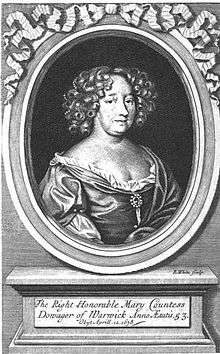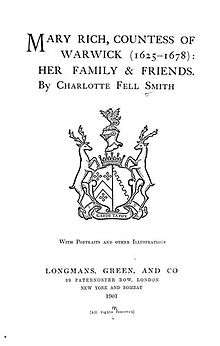Mary Rich, Countess of Warwick
Mary Rich, Countess of Warwick (8 November 1625 – 12 April 1678) was the seventh daughter of Richard Boyle, 1st Earl of Cork, and his second wife, Catherine Fenton, only daughter of Sir Geoffrey Fenton and Alice Weston.[1] She was born in 1625 in Youghal, County Cork, and after her mother's death in 1628 she was raised by her relatives Sir Richard and Lady Clayton in Mallow before becoming a maid of honour to Queen Henrietta Maria. In 1641 she married Charles Rich, 4th Earl of Warwick, and they had two children who died young.[2]

Rich is well known for her great love of literature and the diaries she kept from 1666 to 1677, which included many of the current events in seventeenth-century Ireland as well as her own domestic issues.[3]
Life
Childhood and adolescence
Mary was noted from childhood onwards for her exceptional stubbornness and independence; her father, who was probably the most formidable figure in Irish politics at the time, called her "my unruly daughter" and was entirely unable to control her.[4] He arranged a marriage for her with Lord Clanbrassil but Mary, who was only thirteen, refused to marry Clanbrassil on the grounds of her "incurable aversion" to him, and no threat or argument would change her mind.[5] Her father cut off her allowance, leaving her without any money to buy new clothes, but to no avail.[6] Two years later, having been banished from her father's house to another abode near Hampton Court, she made a secret love marriage with Charles Rich, 4th Earl of Warwick, who was then a penniless younger son with no financial prospects, who had frequently visited her when she was recovering from an attack of measles.[6] Her father, who was clearly fond of her despite their differences, relented sufficiently to provide quite a generous dowry.
Though Mary may have been known as Richard Boyle's "unruly daughter," she still expressed in her writings great respect and gratitude for him. In one of her diary entries she noted that her heart was
gratefully affected for God's good and strange providence in raising my family, by my father, from a mean and low beginning, to be one of the greatest men of fortune in Ireland.[1]
Adulthood
Although she relied on her independence, Mary was known as a good woman with Puritan values. Her life illustrates the remarkable journey of an Irish woman who was committed to her life and virtues in the seventeenth century. Mary's experiences, which she usually kept record of in her autobiography, letters, and diary generally upheld her code of ethics.
Charles unexpectedly inherited the earldom of Warwick in 1659, and thereafter Mary lived mainly at Leigh's Priory near Felstead, Essex, where she helped to raise her husband's three nieces. As the years passed she became increasingly devout, spending much of her day in prayer and meditation. Leigh's Priory became a resort for bishops and clergy. Her diaries record her religious fervour; they also reflect her increasingly bitter quarrels with her husband, whose character was ruined by twenty years of chronic pain from. gout, and by the tragic deaths of their son and daughter. They were reconciled before his death in 1673, and he left her his estate for life.[1] Mary died five years later, and by her own wish was buried "with no pomp." There were no surviving children.
Publications

Mary Rich kept a diary for the last eleven years of her life, in which she recorded her day-to-day affairs and other occurrences throughout the period (1660s).
After her husband's death in 1673, Mary underwent extreme grief as expressed in the following diary entry:
This greatest trial of my life did for a long time disorder my frail house of clay, and made me have thoughts that my dissolution was near; which thoughts were not at all terrible or affrighting to me, but very pleasant and delightful.[2]
Her diary's historical value is considerable, as supplying precise dates for many events, both public and domestic, of the period immediately after the Restoration. Viewed as a human document only, it is equally interesting, affording as it does an insight into the mind of a woman of a type so foreign to that we are accustomed to connect with the decadent years of the later Stuarts.[7]
In addition to her diary, Mary Rich also wrote many letters to various correspondents. According to Illustrious Irishwomen, the people to whom she wrote were often distinguished in the literary world.
Lastly, she also wrote her Occasional Meditations. Rich in domestic detail, vivid analogies, and homely comparisons, the Countess of Warwick's occasional mediations are a memorable expression of a deeply religious woman who achieved a distinctive sense of self as she strove to make her life one with God. This first edition is a testament of her accomplishment.[8]
Excerpt
The following is a sample piece from Mary Rich's diary:
O, we do all offend !
There's not a day of wedded life, if we
Count at its close the little, bitter sum
Of thoughts and words and looks unkind and froward,
Silence that chides, and woundings of the eye,
But prostrate at each other's feet we shouldEach night forgiveness ask.[7]
References
- Fell Smith, Charlotte . Dictionary of National Biography. London: Smith, Elder & Co. 1885–1900. Volume 48
- Elizabeth Owens Blackburne, Illustrious Irishwomen
- Maes, Marc A. 17th Century Women
- Lenox-Conyngham, Melosina Diaries of Ireland Lilliput Press Dublin 1998 p.13
- Fraser, Antonia "Mary Rich, Countess of Warwick" History Today Volume 31
- Lenox-Conyngham p.15
- Fell Smith, Charlotte Mary Rich, Countess of Warwick (1625–1678): Her Family and Friends
- Anselment, Raymond A. The Occasional Meditations of Mary Rich, Countess of Warwick